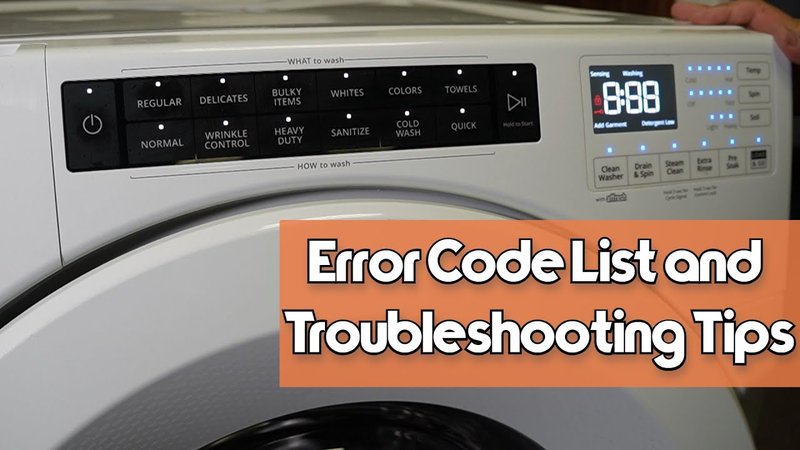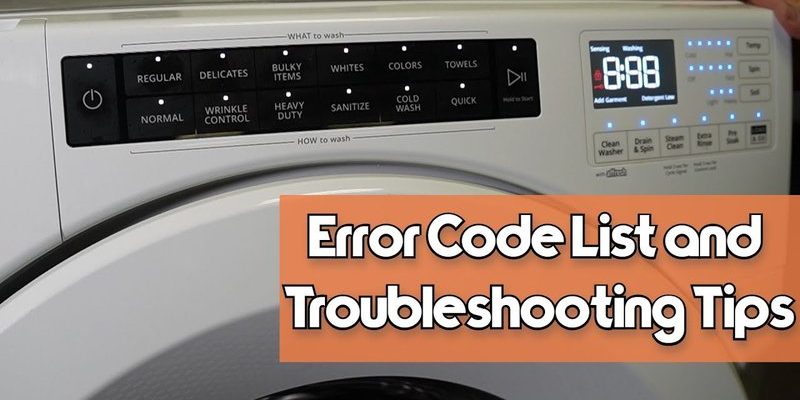
You might be thinking, “Can I just hit reset and get back to my day?” Well, resetting is often the first line of defense. It’s like rebooting your computer when it starts acting up. But, just like a computer, there might be more going on beneath the surface. Here’s the deal: resetting your washing machine can be a quick fix, but it might not always solve the root of the problem.
Understanding the Error Code UE
So, what exactly does this UE code mean for your washer? Let’s break it down. The UE error code pops up when your washing machine thinks the drum is out of balance. Imagine trying to spin a top that’s lopsided. It’ll wobble and might fall over—your washing machine feels the same way. When clothes clump together, the drum can’t spin evenly, causing the UE code to flash.
Now, you might be wondering how this happens. Often, it’s because the load is too small or unevenly distributed. If you’re washing a single heavy item, like a large towel or a couple of jeans, they can bunch up during the spin, causing imbalance. Or if you just tossed clothes in willy-nilly without thinking, they might not be spread out evenly, triggering the sensor.
So, before you panic or call for service, think about your last load. Did you throw in a weird mix of garments? Or maybe you washed something bulky? These little factors can make a big difference. Next time, try rearranging the clothes or adding a few smaller items to even out the load. This simple step might save you from seeing that error again.
Resetting Your Washing Machine
Okay, back to the big question: can resetting fix the UE error code? The short answer is—sometimes. Resetting is like giving your washing machine a clean slate. It often clears out temporary glitches and lets the machine recalibrate. To reset, unplug your washer from the power source and wait a few minutes before plugging it back in. It’s like rebooting your phone; sometimes all it needs is a fresh start.
But here’s a catch: if the underlying issue of imbalance isn’t addressed, the error might just pop up again. Think of it as putting a band-aid on a bigger wound; it might hold for a bit, but it’s not a permanent solution. So while resetting can help, it’s crucial to check the distribution of clothes inside.
Sometimes, even after resetting, the UE error persists. This could mean there’s a deeper issue at play, like a worn suspension part or a problem with the sensor itself. In such cases, resetting won’t help much, and it might be time to call for a professional look.
Preventing Future UE Errors
Now that you’ve been briefed on the UE code and the reset hack, let’s talk prevention. Because, after all, who wants to deal with the same problem over and over? First, always try to distribute laundry evenly in the drum. This sounds simple, but balancing the load can dramatically reduce imbalance issues.
Consider the load size too. Washing machines aren’t huge fans of either extremely small or extremely large loads. If you’re only washing a few items, add a couple of small towels to help with balance. For larger loads, ensure there’s enough space for the clothes to move freely during the spin cycle.
Finally, keep an eye on your machine’s performance. If you notice it’s frequently showing the UE code despite your best efforts, it might be time for a professional check-up. Sometimes, regular maintenance can prevent bigger problems down the line, much like how regular oil changes keep a car running smoothly.
When to Seek Professional Help
If resetting and balancing the load haven’t worked, it might be time to consider calling in the experts. Persistent UE errors could indicate a mechanical issue, like worn suspension rods or a faulty control board. Think of it like a car making a funny noise; sometimes, only a mechanic can diagnose and fix the issue.
When you do decide to seek help, it’s helpful to have details on hand, like the model number of your machine and any other error codes you might have seen. This information can assist the technician in diagnosing the issue more efficiently.
Remember, while it’s tempting to try and fix everything yourself, some problems are best left to professionals. They have the tools and expertise to diagnose and resolve complex issues, ensuring your washer runs smoothly long-term. So, if you’ve tried all the DIY tricks and nothing’s worked, don’t hesitate to call for expert assistance. It’s all about getting back to hassle-free laundry days, right?
